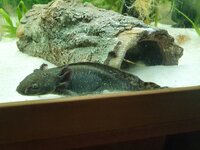Hrafn
New member
I've Had my axolotl for about 9 months now and recently I've been noticing white spots in him that I don't think were there before. He is a wild type axolotl and I read somewhere that their colors can change slightly with age. I also read that it could be scar tissue which might make sense cause when i got him he had damaged gill and a damaged fin. He has been acting normal and has been eating and pooping like normal but I think he has been hiding a bit more than usual. Parameters and temps are fine. I will attach images. Any help is appreciated.




